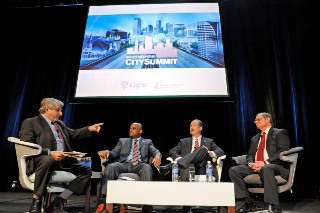

Redefining the modern Rocky Mountain city
Gigi Sukin //March 10, 2014//
 Regional collaboration and uplifting the urban metropolis are the keys to economic and political recovery, said officials meeting at the 4th annual Rocky Mountain CitySummit in Denver last week.
Regional collaboration and uplifting the urban metropolis are the keys to economic and political recovery, said officials meeting at the 4th annual Rocky Mountain CitySummit in Denver last week.
Formerly called the Rocky Mountain Urban Leadership Symposium, the event brought together political officials, business leaders and urban planners to champion collaboration in the Rocky Mountain West.
“Regional cooperation is the great change agent after the Great Recession,” said Brittany Morris Saunders, the Downtown Denver Partnership Inc.’s vice president of public affairs.
The DDP’s daylong, invitation-only event brought together about 600 people, up from 250 in 2010, representing Arizona, Colorado, Idaho, Montana, New Mexico, Nevada, Utah and Wyoming.
Roll call for presenters, panelists and key players included Benjamin Barber, author of If Mayors Ruled the World, Kimball Musk, founder of The Kitchen and nonprofit The Kitchen Community, and The Atlantic Senior Editor Richard Florida. Gov. John Hickenlooper joined Denver Mayor Michael Hancock, Albuquerque Mayor Richard Berry and Cheyenne Mayor Richard Kaysen for a panel discussion.
Florida, author of The Rise of the Creative Class, and leading urban theorist, spoke on the “rise of the knowledge [or creative] economy.”
“When humans are concentrated in a community, they leverage each other’s productivity, creating a competitive and collaborative environment,” Florida said. “The past decade’s shift of technology, high-tech and startups to urban areas shocks even me.”
Florida argued the American dream has evolved in an attempt to achieve “quality of place,” where people can live, work and play in one common venue. He presented car-sharing programs and the attraction to urban housing as effective examples of his proposed “economic transformation [that] will be the greatest in all of human history.”
As such, “We’re seeing the re-urbanization of the city core,” he said, adding that investment dollars are being reallocated accordingly.
Historically, the Summit has featured speakers from the Brookings Institute, a Washington, D.C.-based think tank focused on urbanization, and this year was no exception, with Jennifer Bradley, Fellow at the Brookings Metropolitan Program and co-author of The Metropolitan Revolution. A full chapter of the 2013 book by Bradley and Brookings Vice President Bruce Katz centers on Denver, citing cultural collaborations such as the Scientific and Cultural Facilities Distrcit and emphasizing the regional collaboration inspired by the in-the-works FasTracks mass transit project.
“Denver is well-known as a collaborative region,” Bradley said.
Questions continue to linger, however, over how to make collaboration work for all interested and invested parties. Katherine Correll, executive director of Downtown Colorado Inc., a nonprofit, member association with the mission to build statewide commercial districts and town centers, inquired as to the role of rural communities in the “metropolitan revolution.”
“Colorado can be characterized as distinct regions with separate demographics, economies and characteristics, but all of Colorado’s distinct regions are interdependent [whether they like it or not] and rely on shared, common natural resources…” Correll said.
Earlier at the event, Barber asserted that 80 percent of GDP is produced in city centers. “While rural friends blame cities for spending all the wealth, they are in fact the wealth producers.”
Correll suggested that the chief challenge across the state of Colorado is to identify and maintain the necessary tool for city building, including tax increment financing and credits to reinvigorate neglected historic sites that “create missing teeth in the smiles of our downtowns.”
“Urban areas lead the way toward collaboration and innovation, but metro area leaders also [must] consider the idea of stewardship and how best to share these advancements with smaller, rural, remote communities or the geographic divisions of our large Rocky Mountain states will continue to expand economic divisions and inequality.”
(photo: Larry Laszlo)

























